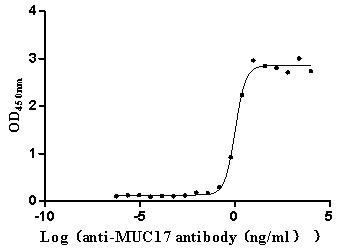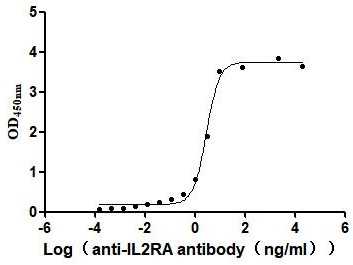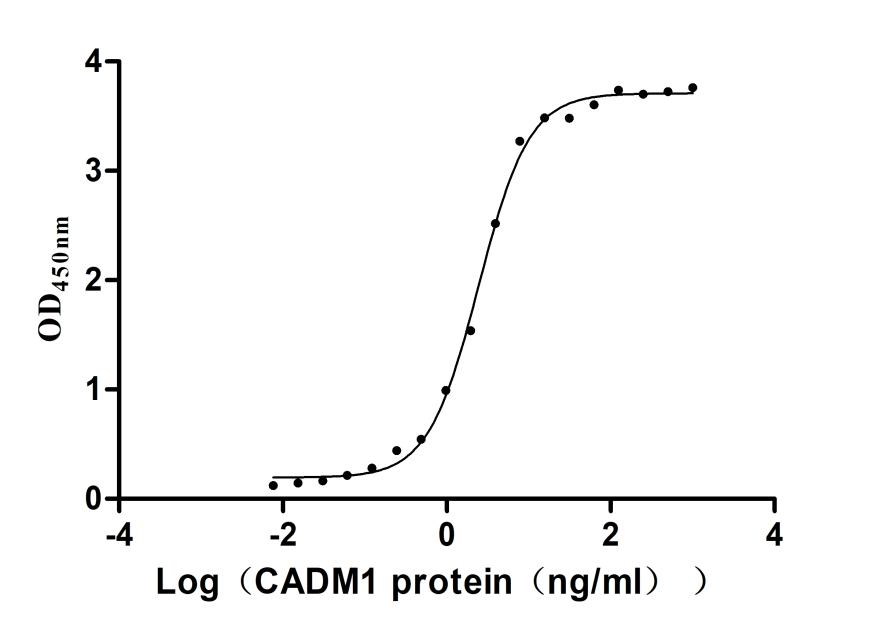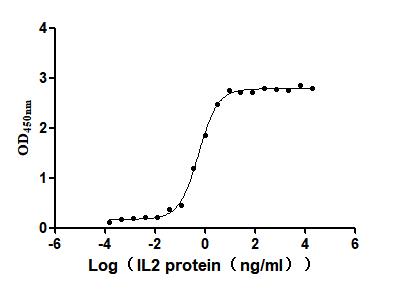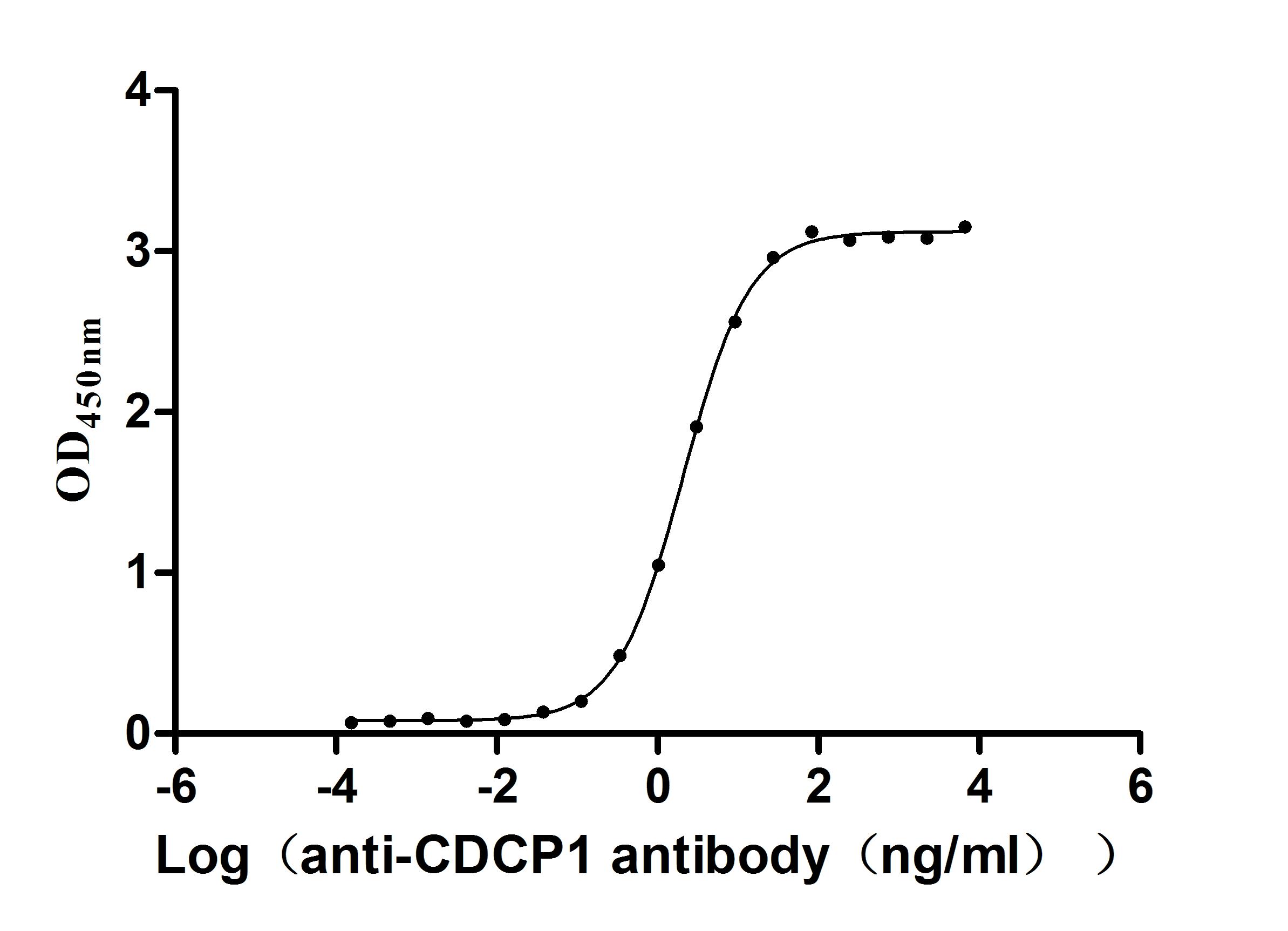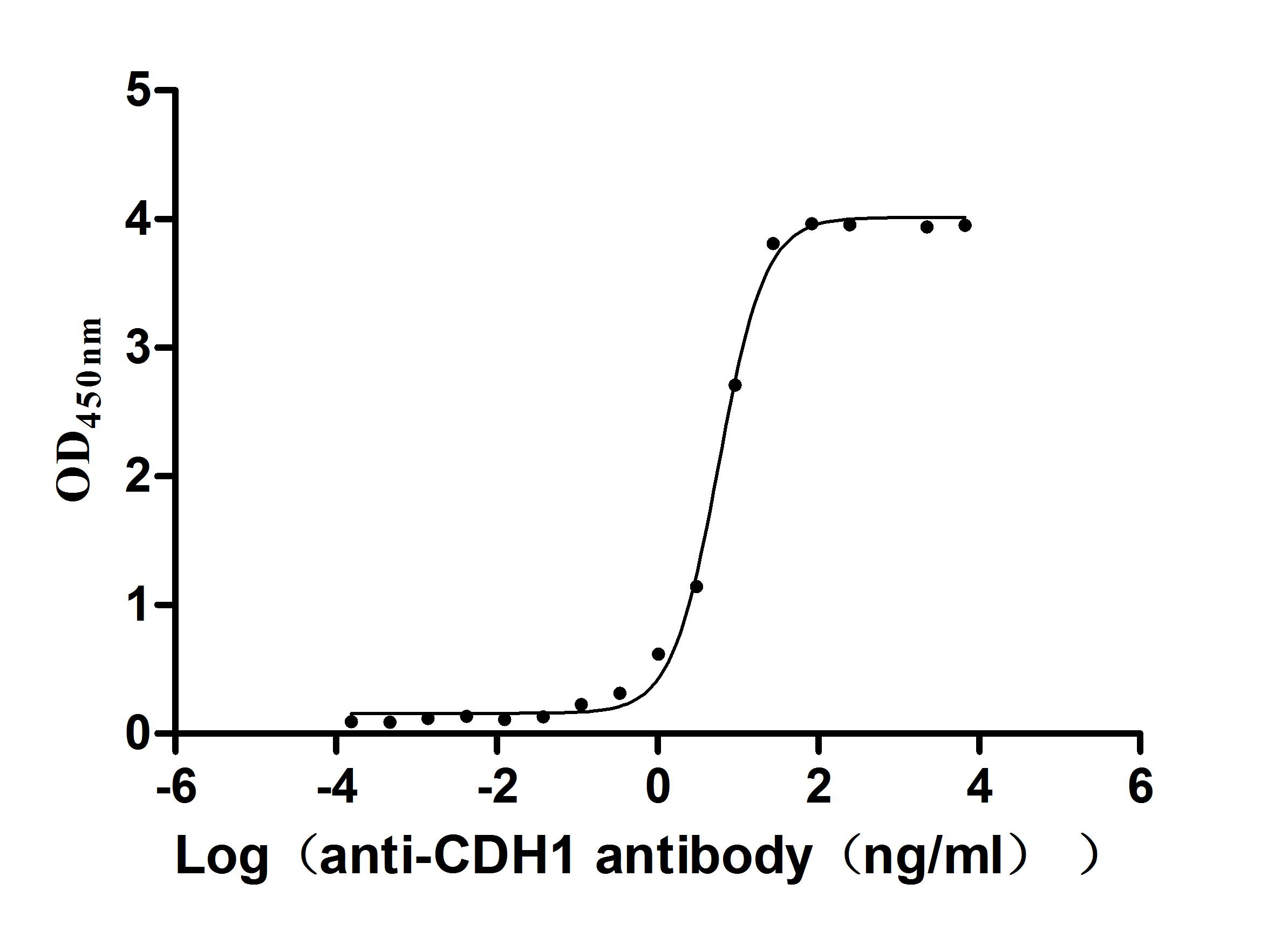Recombinant Mouse Potassium channel subfamily K member 3 (Kcnk3)
-
中文名稱:小鼠Kcnk3重組蛋白
-
貨號:CSB-CF012071MO
-
規格:
-
來源:in vitro E.coli expression system
-
其他:
產品詳情
-
基因名:Kcnk3
-
Uniprot No.:
-
別名:Kcnk3; Ctbak; Task; Task1; Potassium channel subfamily K member 3; Acid-sensitive potassium channel protein TASK-1; Cardiac two pore background K(+ channel; TWIK-related acid-sensitive K(+ channel 1; Two pore potassium channel KT3.1; Two pore K(+ channel KT3.1; cTBAK-1
-
種屬:Mus musculus (Mouse)
-
蛋白長度:Full length protein
-
表達區域:1-409
-
氨基酸序列MKRQNVRTLALIVCTFTYLLVGAAVFDALESEPEMIERQRLELRQLELRARYNLSEGGYE ELERVVLRLKPHKAGVQWRFAGSFYFAITVITTIGYGHAAPSTDGGKVFCMFYALLGIPL TLVMFQSLGERINTFVRYLLHRAKRGLGMRHAEVSMANMVLIGFVSCISTLCIGAAAFSY YERWTFFQAYYYCFITLTTIGFGDYVALQKDQALQTQPQYVAFSFVYILTGLTVIGAFLN LVVLRFMTMNAEDEKRDAEHRALLTHNGQAVGLGGLSCLSGSLGDGVRPRDPVTCAAAAG GVGVGVGGSGFRNVYAEVLHFQSMCSCLWYKSREKLQYSIPMIIPRDLSTSDTCVEHSHS SPGGGGRYSDTPSHPCLCSGTQRSAISSVSTGLHSLAAFRGLMKRRSSV
Note: The complete sequence may include tag sequence, target protein sequence, linker sequence and extra sequence that is translated with the protein sequence for the purpose(s) of secretion, stability, solubility, etc.
If the exact amino acid sequence of this recombinant protein is critical to your application, please explicitly request the full and complete sequence of this protein before ordering. -
蛋白標簽:N-terminal 10xHis-tagged
-
產品提供形式:Liquid or Lyophilized powder
Note: We will preferentially ship the format that we have in stock, however, if you have any special requirement for the format, please remark your requirement when placing the order, we will prepare according to your demand. -
緩沖液:Lyophilized from Tris/PBS-based buffer, 6% Trehalose, pH 8.0
-
儲存條件:Store at -20°C/-80°C upon receipt, aliquoting is necessary for mutiple use. Avoid repeated freeze-thaw cycles.
-
保質期:The shelf life is related to many factors, storage state, buffer ingredients, storage temperature and the stability of the protein itself.
Generally, the shelf life of liquid form is 6 months at -20°C/-80°C. The shelf life of lyophilized form is 12 months at -20°C/-80°C. -
貨期:Basically, we can dispatch the products out in 1-3 working days after receiving your orders. Delivery time may differ from different purchasing way or location, please kindly consult your local distributors for specific delivery time.Note: All of our proteins are default shipped with normal blue ice packs, if you request to ship with dry ice, please communicate with us in advance and extra fees will be charged.
-
注意事項:Repeated freezing and thawing is not recommended. Store working aliquots at 4°C for up to one week.
-
Datasheet & COA:Please contact us to get it.
相關產品
靶點詳情
-
功能:pH-dependent, voltage-insensitive, background potassium channel protein. Rectification direction results from potassium ion concentration on either side of the membrane. Acts as an outward rectifier when external potassium concentration is low. When external potassium concentration is high, current is inward.
-
基因功能參考文獻:
- TASK-1 channels displayed strong cardiac expression in mice. Dysregulation of atrial TASK-1 expression in murine atrial fibrillation and heart failure models suggests potential relevance of TASK-1 currents in arrhythmogenesis. PMID: 29881975
- studies demonstrate that TASK channels can limit ischemia-reperfusion damage in the cortex, and postconditioning with volatile anesthetics provides neuroprotective actions that depend, in part, on activation of TASK currents in cortical neurons. PMID: 28276488
- Whereas adult female TASK-1-/- mice had a virtually normal respiratory phenotype, except for an increased relaxation time, adult male TASK-1-/- mice exhibited enhanced ventilation that was mainly due to an increased tidal volume. Respiratory responses to hypercapnia and hypoxia were largely preserved. In neonatal TASK-1-/- mice, respiratory drive appeared reduced and knockout animals were more prone to experience apnea. PMID: 27838333
- Acute hypercapnia (5% CO2) stimulated ventilation in TASK-1/3(-/-) and wild-type mice to a similar extent; however, at higher CO2 concentrations the stimulation of ventilation was more pronounced in TASK-1/3(-/-) mice. At hyperoxia (100% O2), TASK-1(-/-), TASK-3(-/-) and wild-type mice showed the physiological small decrease of ventilation. TASK-1/3(-/-) mice exhibited an abnormal increase of ventilation under hyperoxia. PMID: 28673876
- Our results have uncovered a previously unknown role of c-Src tyrosine kinase in regulating interneuron function in the brain and identified a novel mechanism by which TASK-1 channels are activated in neurons. PMID: 28714121
- Adipose-specific Kcnk3 knockout mice display increased energy expenditure and are resistant to hypothermia and obesity. PMID: 28988768
- While there is compelling evidence that TASK-1 is involved in the pathogenesis of pulmonary arterial hypertension in humans, the mouse does not appear to serve as a suitable model to study the underlying molecular mechanisms PMID: 28301582
- the K(+) channel TASK1 controls the thermogenic activity in brown adipocytes through modulation of beta-adrenergic receptor signaling. PMID: 26527067
- KCNK3 channels are not involved in hearing. PMID: 26549439
- An important role for TASK-1 channels in limiting pancreatic alpha-cell excitability and glucagon secretion during glucose stimulation. PMID: 25849724
- This study showed TASK channels on cholinergic neurons contribute to endogenous EEG oscillations (including gamma activity) and the electrocortical response to histamine at the basal forebrain in vivo. PMID: 26446210
- Downregulation of TASK_1 increased proliferation rates of N2A cells. PMID: 24848104
- A glucose-dependent role for beta-cell TASK-1 channels of limiting glucose-stimulated Deltapsip depolarization and insulin secretion, which modulates glucose homeostasis. PMID: 24932805
- Oxygen and mitochondrial inhibitors modulate both monomeric and heteromeric TASK-1 and TASK-3 channels in mouse carotid body type-1 cells. PMID: 24042502
- This study demonstrated for the first time that oligodendrocytes express functional TASK-1 channels and provide compelling evidence they contribute to oligodendrocyte damage in hypoxia. PMID: 23567653
- TASK-1 deficiency does neither alter key electrophysiological parameters nor increases atrial/ventricular vulnerability after electrical stimulation. PMID: 22813543
- No difference is found between the pulmonary artery (PA) of wild-type and TASK-1/3-deficient mice; TASK-1 does not form a functional channel in pulmonary artery smooth muscle cells. PMID: 21486782
- TASK-1 is important for the conduction of cardiac excitation and for the ventricular erpolarization under resting conditions of the heart. PMID: 21865850
- TASK channels are not required for the stimulation of aldosterone production by protons but their inhibition by physiological acidosis may contribute to full expression of the steroidogenic response. PMID: 21111026
- Our findings imply that TASK channels regulateFast-spiking neocortex cell rhythmogenesis PMID: 20705896
- TASK-1 plays a functional role in the repolarization of the cardiac action potential in vivo and contributes to the maintenance of heart rate variability. PMID: 20978771
- We have characterized the mouse carotid body with special attention to nicotinic, purinergic and dopaminergic receptors as well as the TASK-1 K(+)-channel PMID: 20452469
- A consequence of having TASK-1 channels expressed (in various non-neuronal tissues and organs) is that neuronal damage is lessened when stroke occurs. PMID: 20167264
- The data of this study indicated that TASK channels in cholinergic neurons are molecular substrates for select actions of inhaled anesthetics PMID: 20519544
- Activation and inhibition of protein kinase G respectively upregulates and downregulates recombinant TASK1 channels heterologously expressed in PKG-loaded human embryonic kidney cells. PMID: 20410120
- Although significantly reducing its pH sensitivity, mutation of H98 in TASK-1 did not abolish pH sensitivity. H98 is not only residue or domain involved in pH sensing of TASK-1. PMID: 12634929
- activation of protein kinase c epsilon is both necessary and sufficient to regulate murine TASK-1 potassium channel current in a heterologous expression system and to induce repolarization abnormalities in isolated myocytes PMID: 15184378
- Expression of TASK-1 in mouse is restricted to the developing conduction system PMID: 16145663
- TASK-1 channels contribute to the properties of potassium leak conductance in adult cerebellar granule neurons PMID: 16339039
- TASK-like conductances are more prevalent in inhibitory interneurons than previously supposed. PMID: 16837582
- Residues in the outer pore mouth contribute to selectivity in TASK-1. Mutations resulting in loss of selectivity were associated with slowing of the response of channels to depolarisation. PMID: 17541788
- Striking changes in adrenocortical architecture in task1-knockout mice are the first demonstration of the causative role of a potassium channel in development/differentiation. PMID: 18034154
- A strict requirement is ruled out for TASK channels or raphe neurons in central respiratory chemosensation. PMID: 18094244
- studies establish an animal model of nontumorigenic primary hyperaldosteronism and identify TASK channels as a possible therapeutic target for primary hyperaldosteronism PMID: 18250325
- TASK-1 channels play a key role in the control of ventilation by peripheral chemoreceptors. PMID: 18753386
- data provide evidence for an important role of functional TASK channels in limiting tissue damage during cerebral ischemia PMID: 18930826
- In the isolated, perfused, and ventilated mouse lung model, anandamide and ET-1 have an additive effect on TASK-1 inhibition and resultant vasoconstriction. PMID: 19188660
- Our results support a novel role for TASK genes in enhancing neuronal excitability and promoting high-frequency firing, but suggest that TASK1/3 subunits are not essential for orexin cell responses to glucose and pH. PMID: 19508695
顯示更多
收起更多
-
亞細胞定位:Cell membrane; Multi-pass membrane protein.
-
蛋白家族:Two pore domain potassium channel (TC 1.A.1.8) family
-
組織特異性:Very strong expression in heart, also detected in kidney, brain, skin, testis, lung, skeletal muscle, small intestine and stomach. Not detected in liver, thymus or spleen.
-
數據庫鏈接:
Most popular with customers
-
Recombinant Severe acute respiratory syndrome coronavirus Spike glycoprotein (S), partial (Active)
Express system: Mammalian cell
Species: Human SARS coronavirus (SARS-CoV) (Severe acute respiratory syndrome coronavirus)
-
Recombinant Human Pro-neuregulin-1, membrane-bound isoform (NRG1), partial (Active)
Express system: Mammalian cell
Species: Homo sapiens (Human)
-
Recombinant Human Mucin-17 (MUC17), partial (Active)
Express system: Mammalian cell
Species: Homo sapiens (Human)
-
Recombinant Human Interleukin-2 receptor subunit alpha (IL2RA), partial (Active)
Express system: Mammalian cell
Species: Homo sapiens (Human)
-
Recombinant Human Cytotoxic and regulatory T-cell molecule (CRTAM), partial (Active)
Express system: Mammalian cell
Species: Homo sapiens (Human)
-
Recombinant Human Interleukin-2 (IL2) (Active)
Express system: Mammalian cell
Species: Homo sapiens (Human)
-
Recombinant Macaca fascicularis CUB domain containing protein 1 (CDCP1), partial (Active)
Express system: Mammalian cell
Species: Macaca fascicularis (Crab-eating macaque) (Cynomolgus monkey)
-
Recombinant Human Cadherin-1(CDH1),partial (Active)
Express system: Mammalian cell
Species: Homo sapiens (Human)


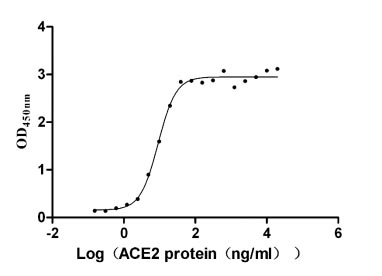
-AC1.jpg)
